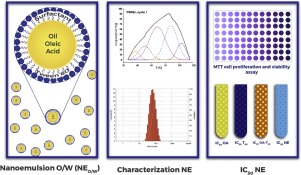当前位置:
X-MOL 学术
›
Colloids Surf. B Biointerfaces
›
论文详情
Our official English website, www.x-mol.net, welcomes your
feedback! (Note: you will need to create a separate account there.)
Nanostructured oleic acid/polysorbate 80 emulsions with diminished toxicity in NL-20 cell line: Insights of potential drug carriers.
Colloids and Surfaces B: Biointerfaces ( IF 5.4 ) Pub Date : 2019-12-30 , DOI: 10.1016/j.colsurfb.2019.110758 María Luisa de Lourdes Pérez-González 1 , Claudia Haydée González-de la Rosa 2 , Gerardo Pérez-Hernández 2 , Hiram Isaac Beltrán 3
Colloids and Surfaces B: Biointerfaces ( IF 5.4 ) Pub Date : 2019-12-30 , DOI: 10.1016/j.colsurfb.2019.110758 María Luisa de Lourdes Pérez-González 1 , Claudia Haydée González-de la Rosa 2 , Gerardo Pérez-Hernández 2 , Hiram Isaac Beltrán 3
Affiliation

|
Nanoemulsions (NE) are nowadays required drug nanocarriers. We have selected i) oleic acid (OA) as oil (O), ii) polysorbate 80 (PS80) as surfactant (S), and iii) water (W) in a prototype NE. Our best formulation had O:S ratio [OA]/[PS80] = 0.0708/0.0382 = 1.85 [mol·L-1], implying 1.85 parts of OA covered/stabilized by 1 part of PS80, giving 71.86 nm and 0.42 polydispersity index (PDI) in NE, determined by DLS and TEM. These nanosystems stored at room temperature/darkness stabilized up to 12 months (measured by DLS and TEM) maintaining very similar particle sizes and sometimes decreasing PDI. NE stability was determined by DSC, evidencing reversibility upon heating from 25 to 100 °C, increasing to 125 °C (sealed systems) produced more attenuated heating profiles in second and third cycles, compared with first, indicating partial but enough stability for storage means. NE cytotoxicity tests were conducted on immortalized normal lung epithelial cells (NL-20), as reference. The results show 50 % inhibitory concentrations (IC50,μM) of 1100, OA, and 2.6, PS80. The IC50 was 20.5, PS80 (PS80@NE) and 37.9, OA (OA@NE) clearly indicating that components changed their toxicities upon nanostructuring, OA exhibited 30-fold increase (IC50(OA) 1100.0→37.9) while PS80, decreased 7.9-fold (IC50(PS80) 2.6→20.5). PS80 is the most toxic component but when is included in PS80@NE, less toxic nanocarriers were generated.
中文翻译:

NL-20 细胞系中毒性降低的纳米结构油酸/聚山梨醇酯 80 乳液:潜在药物载体的见解。
纳米乳剂(NE)是当今所需的药物纳米载体。我们在原型 NE 中选择了 i) 油酸 (OA) 作为油 (O),ii) 聚山梨醇酯 80 (PS80) 作为表面活性剂 (S),以及 iii) 水 (W)。我们最好的配方具有 O:S 比 [OA]/[PS80] = 0.0708/0.0382 = 1.85 [mol·L-1],这意味着 1.85 份 OA 被 1 份 PS80 覆盖/稳定,得到 71.86 nm 和 0.42 多分散指数(PDI) 在 NE,由 DLS 和 TEM 确定。这些在室温/黑暗下储存的纳米系统可以稳定长达 12 个月(通过 DLS 和 TEM 测量),保持非常相似的粒径,有时还会降低 PDI。NE 稳定性由 DSC 确定,证明从 25 到 100 °C 加热时的可逆性,升高到 125 °C(密封系统)在第二个和第三个循环中产生更多衰减的加热曲线,与第一个相比,表示存储装置的部分但足够的稳定性。作为参考,对永生化的正常肺上皮细胞 (NL-20) 进行 NE 细胞毒性试验。结果显示 1100 OA 和 2.6 PS80 的 50 % 抑制浓度 (IC50,μM)。IC50 为 20.5, PS80 (PS80@NE) 和 37.9, OA (OA@NE) 清楚地表明组分在纳米结构上改变了它们的毒性, OA 增加了 30 倍 (IC50(OA) 1100.0→37.9) 而 PS80, 减少了 7.9 -折叠(IC50(PS80)2.6→20.5)。PS80 是毒性最强的成分,但当包含在 PS80@NE 中时,会产生毒性较小的纳米载体。OA (OA@NE) 清楚地表明组分在纳米结构中改变了它们的毒性,OA 增加了 30 倍(IC50(OA)1100.0→37.9),而 PS80 减少了 7.9 倍(IC50(PS80)2.6→20.5)。PS80 是毒性最强的成分,但当包含在 PS80@NE 中时,会产生毒性较小的纳米载体。OA (OA@NE) 清楚地表明组分在纳米结构中改变了它们的毒性,OA 增加了 30 倍(IC50(OA)1100.0→37.9),而 PS80 减少了 7.9 倍(IC50(PS80)2.6→20.5)。PS80 是毒性最强的成分,但当包含在 PS80@NE 中时,会产生毒性较小的纳米载体。
更新日期:2019-12-30
中文翻译:

NL-20 细胞系中毒性降低的纳米结构油酸/聚山梨醇酯 80 乳液:潜在药物载体的见解。
纳米乳剂(NE)是当今所需的药物纳米载体。我们在原型 NE 中选择了 i) 油酸 (OA) 作为油 (O),ii) 聚山梨醇酯 80 (PS80) 作为表面活性剂 (S),以及 iii) 水 (W)。我们最好的配方具有 O:S 比 [OA]/[PS80] = 0.0708/0.0382 = 1.85 [mol·L-1],这意味着 1.85 份 OA 被 1 份 PS80 覆盖/稳定,得到 71.86 nm 和 0.42 多分散指数(PDI) 在 NE,由 DLS 和 TEM 确定。这些在室温/黑暗下储存的纳米系统可以稳定长达 12 个月(通过 DLS 和 TEM 测量),保持非常相似的粒径,有时还会降低 PDI。NE 稳定性由 DSC 确定,证明从 25 到 100 °C 加热时的可逆性,升高到 125 °C(密封系统)在第二个和第三个循环中产生更多衰减的加热曲线,与第一个相比,表示存储装置的部分但足够的稳定性。作为参考,对永生化的正常肺上皮细胞 (NL-20) 进行 NE 细胞毒性试验。结果显示 1100 OA 和 2.6 PS80 的 50 % 抑制浓度 (IC50,μM)。IC50 为 20.5, PS80 (PS80@NE) 和 37.9, OA (OA@NE) 清楚地表明组分在纳米结构上改变了它们的毒性, OA 增加了 30 倍 (IC50(OA) 1100.0→37.9) 而 PS80, 减少了 7.9 -折叠(IC50(PS80)2.6→20.5)。PS80 是毒性最强的成分,但当包含在 PS80@NE 中时,会产生毒性较小的纳米载体。OA (OA@NE) 清楚地表明组分在纳米结构中改变了它们的毒性,OA 增加了 30 倍(IC50(OA)1100.0→37.9),而 PS80 减少了 7.9 倍(IC50(PS80)2.6→20.5)。PS80 是毒性最强的成分,但当包含在 PS80@NE 中时,会产生毒性较小的纳米载体。OA (OA@NE) 清楚地表明组分在纳米结构中改变了它们的毒性,OA 增加了 30 倍(IC50(OA)1100.0→37.9),而 PS80 减少了 7.9 倍(IC50(PS80)2.6→20.5)。PS80 是毒性最强的成分,但当包含在 PS80@NE 中时,会产生毒性较小的纳米载体。











































 京公网安备 11010802027423号
京公网安备 11010802027423号